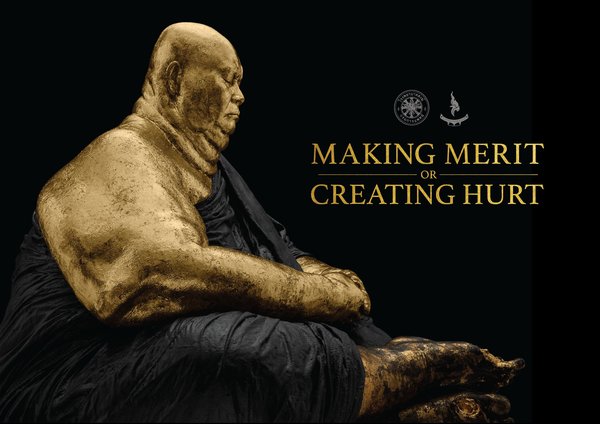-Buddhists in Thailand urged to reshape way of merit-making as issue of obesity in monks worsens
BANGKOK, April 26, 2019 /PRNewswire/ — Health and religious authorities in Thailand lead a campaign to raise awareness on skyrocketing obesity among monks and urge Buddhist devotees to be mindful of the food they prepare for them.
To help Buddhists learn about this silent threat to the monks, Thailand’s Priest Hospital (Buddhist Monk Hospital), in collaboration with Baramee Dhamma Hall Foundation and Ogilvy Thailand, has created the “Making Merit or Creating Hurt” campaign to promote a leaner, healthier clerical living by protecting the monks from unhealthy foods through public displays of sculptural art.
This campaign launched in the first week of April, when sculptures of healthy, lean monks were found at temples, marketplaces, hospitals and meditation retreats across Bangkok, Thailand. Then, when the public returned to the same spots two weeks later during Songkran holiday, a national holiday during which Buddhists gather at temples to celebrate the Thai New Year by making merits and offering food to monks, the display changed to a miserable-looking, obese monk suffering from diabetic wounds on the foot.
An MMS containing information about the campaign was sent to individuals in close proximity to the sculpture exhibition via a location-based service. The campaign’s website, www.obesitymonk.com, was also included in the message to provide receivers with more details as well as nutritious food recipes which are applicable to Buddhist monks’ diet.
The tradition of Buddhism has been rooted in Thailand and the majority of Asia for over two thousand years. A large portion of Thai Buddhists, which account for 95% of the country’s population, believe that the act of donating food to monks not only grants blessings for themselves, but is also a spiritual way to share alms with their loved ones who have passed away. For many day-to-day occasions, it is common for Buddhists to prepare the deceased’s favorite foods for the alms bowl, overlooking the fact that such favored food — often laden with fat and sugar — may do more harm than good to the monks’ health.
Since these offerings largely contain high-cholesterol, highly-seasoned and fatty innutritious foods, the adverse effects would fall onto the monks who are obliged to consume them despite careful consideration. That, combined with the monastic discipline forbidding monks from rejecting food offered by the faithful, as well as the sedentary nature of temple monastic life, has resulted in approximately one-third of 300,000 Buddhist monks in Thailand suffering from extra weight and other related diseases and conditions, such as obesity, diabetes, high cholesterol, hypertension, high blood pressure, coronary heart diseases and joint problems.
“The number of sick monks in Thailand has continued to soar over the last ten years, leading to an expanding amount of medical fees of up to one billion baht for the government to cover,” said Chumni Jittreprasert, M.D, Director of Thailand’s Priest Hospital, who spearheaded the “Making Merit of Creating Hurt” campaign, “This campaign has been made to urge Buddhists to be aware of possible health woes brought upon the monks which may be exacerbated by their own hands.”
The doctor stressed, “The incidents where monks had to have their leg amputated due to incurable diabetic infections or constantly battle chronic cholesterol-related conditions are real, and I believe any Buddhist devotee would be just as startled and upset by this fact. Now that the situation has become a major crisis, we need to solve the issue immediately and deal with the root cause of the ailments. Whether it is a home-cooked meal or a prepared dish from street vendors, the least the merit makers can do is to ensure that the edible choice they make for the monks is nutritious and healthy. To allow the monks to maintain a healthy wellbeing, Buddhists are encouraged to choose low-fat, less-sugary foods for the donation instead of deep-fried, oily, highly-seasoned and oversaturated kinds of food for them.”
Watchara Prayoonkum, the nationally acclaimed sculptor behind the “Obese Monk” statues also weighed in on the issue. He said, “As a Buddhist devotee, it appalls me to see Buddhist monks get sick and suffer. I created this set of sculptures in hope of promoting knowledge on this serious problem, and stressing how unhealthy alms giving, though unintended, can lead to such tragic results. Artistic elements of the sculpture are used to showcase intended meanings, such as severe diabetic wounds, uneven sculpted texture representing extra cellulite and gold coating representing the traditional virtue that unfortunately turns into damage to the religion. I hope these sculptural displays will open the eyes of Buddhists and remind them to be more careful when preparing food for monks.”
For more information about the “Making Merit or Creating Hurt” campaign and downloadable nutritious food recipes, please visit www.obesitymonk.com. Those who are interested can also sign the petition at http://chng.it/FnPxHNWHXR to create a social movement to improve the wellbeing of Buddhist monks in Thailand.
VDO teaser: https://www.youtube.com/watch?v=PozkZHE7GPY&feature=youtu.be
For more information, please contact
Jintana Duangkaew Ogilvy Group (Thailand)
e-mail: jintana.duangkaew@ogilvy.com
tel: +66 8 4 673 8889
Photo – https://photos.prnasia.com/prnh/20190426/2447888-1





Facebook Comments